Mikroelektronika d.o.o.
Tableau de bord de fréquence cardiaque 11
Tableau de bord de fréquence cardiaque 11
Impossible de charger la disponibilité du service de retrait
Key Features
- Mesure de la SpO2 derrière une encre transmissive IR mais visiblement sombre, haute précision d'éclairement sur diverses sources lumineuses, haute sensibilité et résolution, faible consommation d'énergie, détection de mouvement d'objet, et plus encore
- Basé sur l'OB1203 - module de biocapteur tout-en-un entièrement intégré qui mesure la fréquence cardiaque et les niveaux d'oxygène dans le sang de Renesas
- Ce Click board™ peut déterminer la fréquence cardiaque humaine (FC), la saturation en oxygène (SpO2), la fréquence respiratoire et la variabilité de la fréquence cardiaque (une mesure du stress)
- Interface I2C
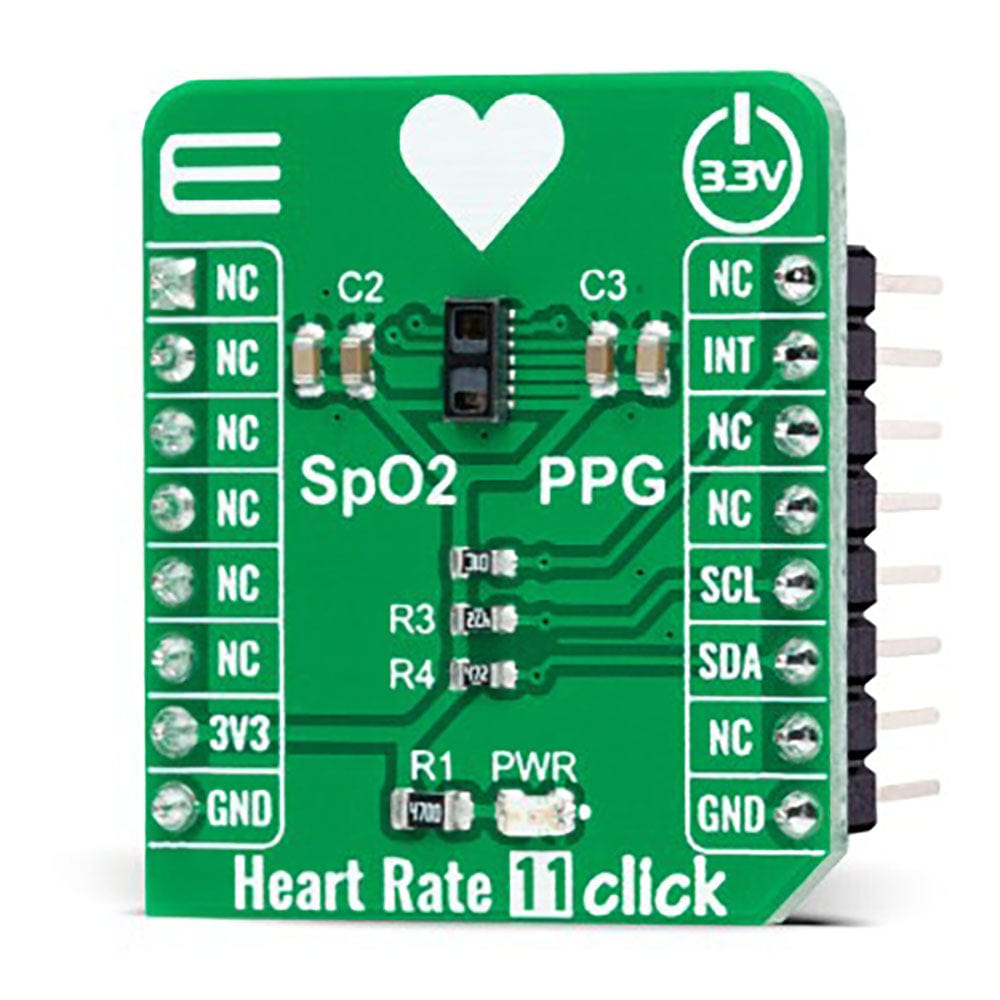
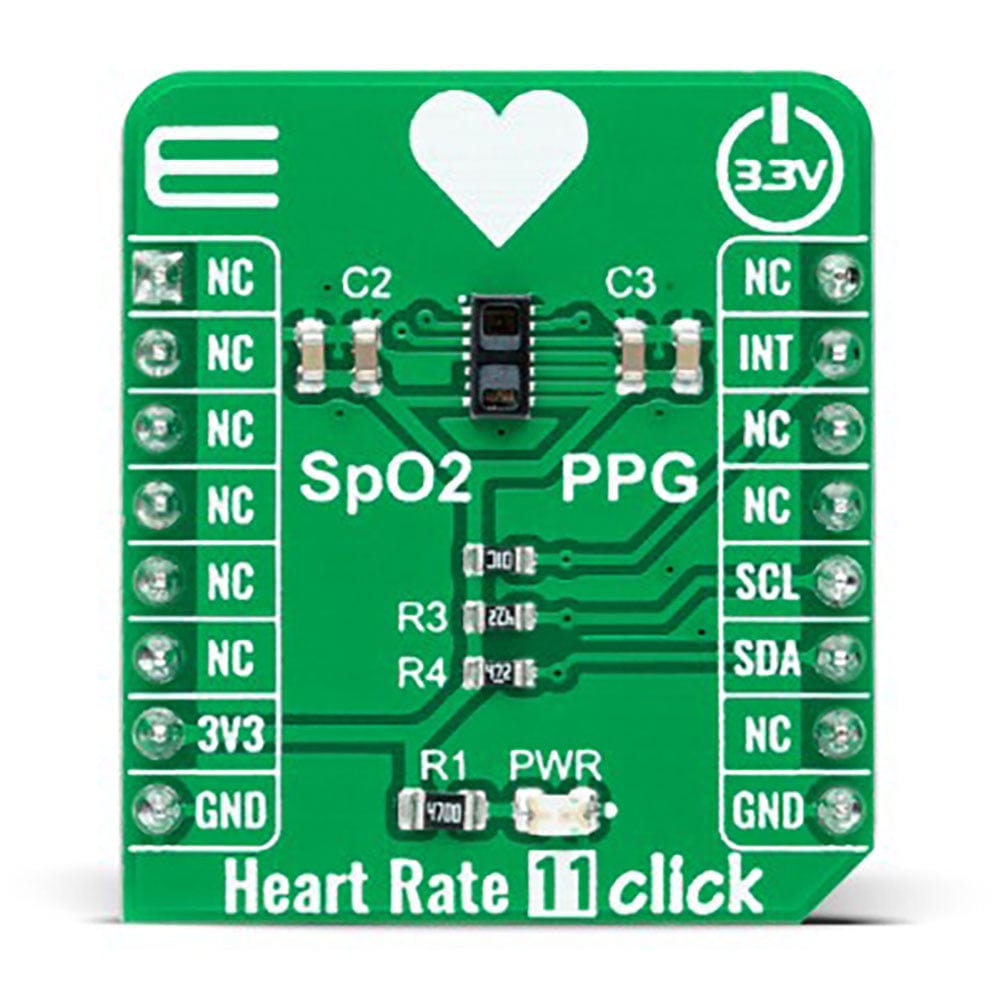
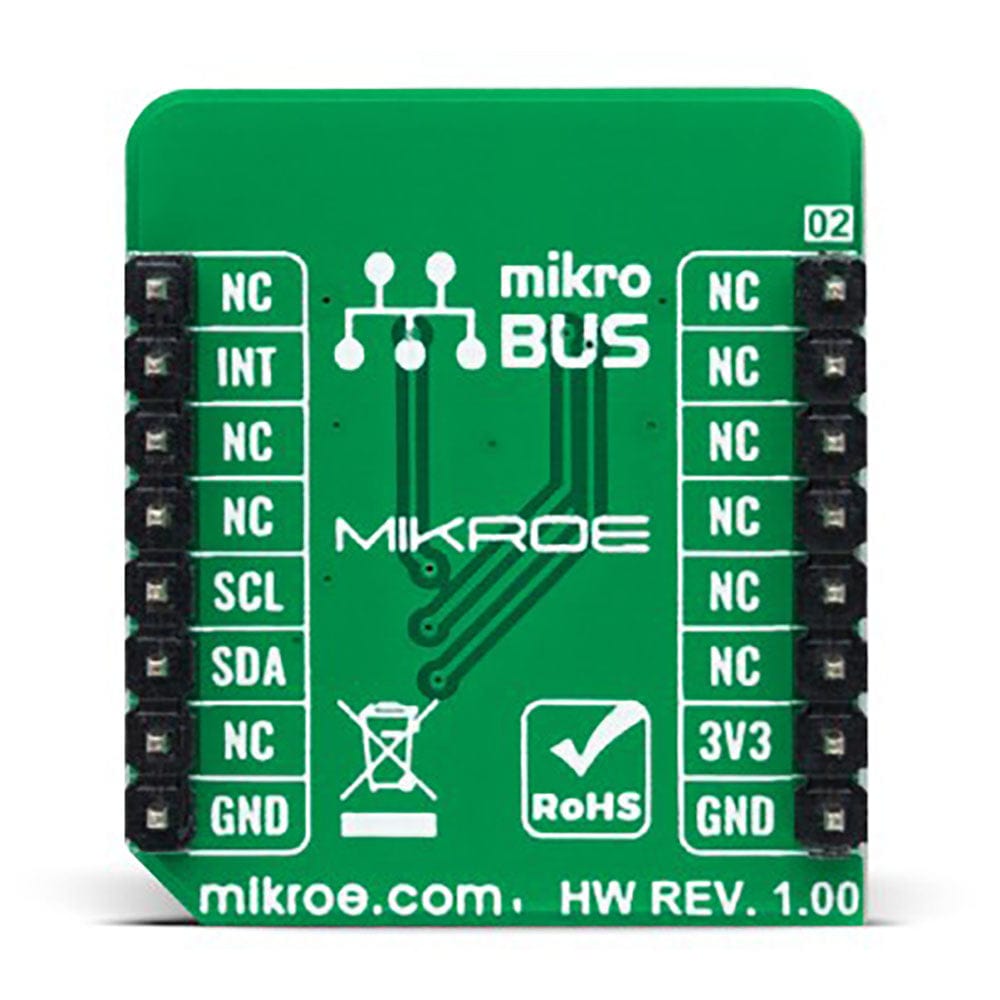
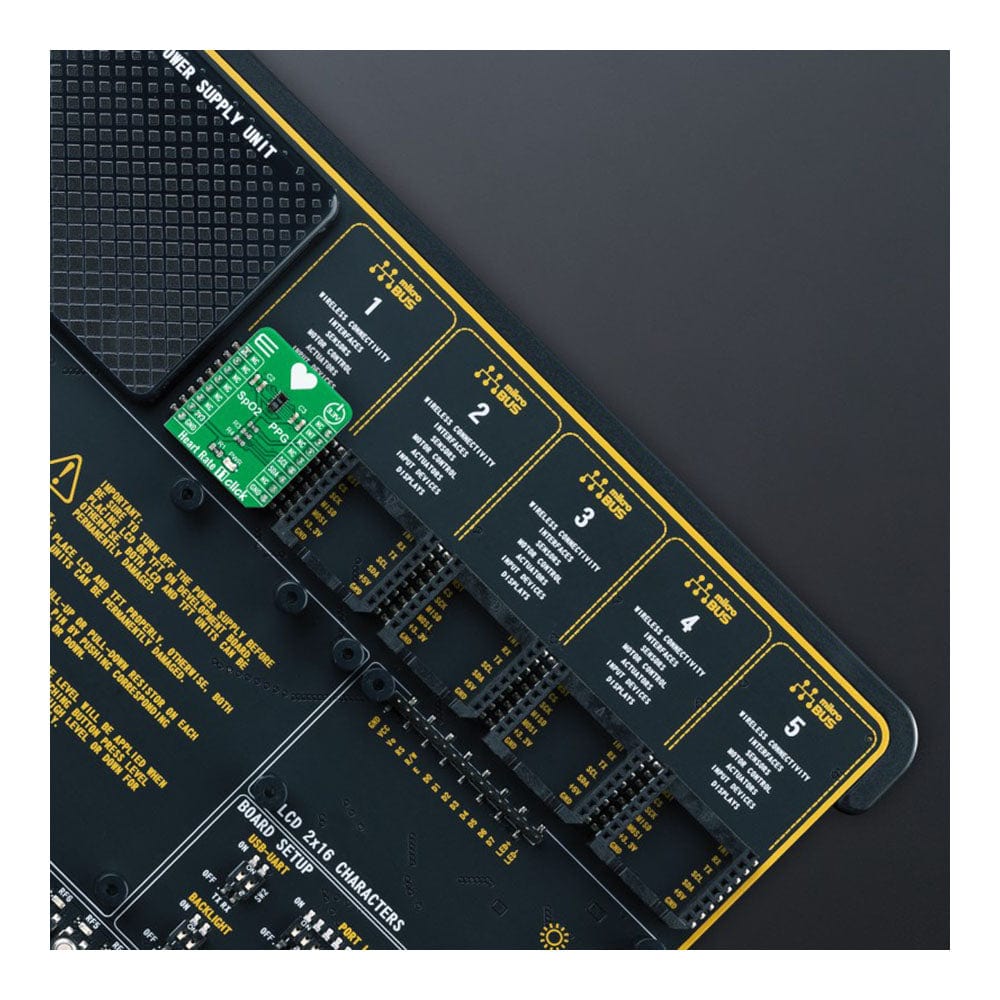
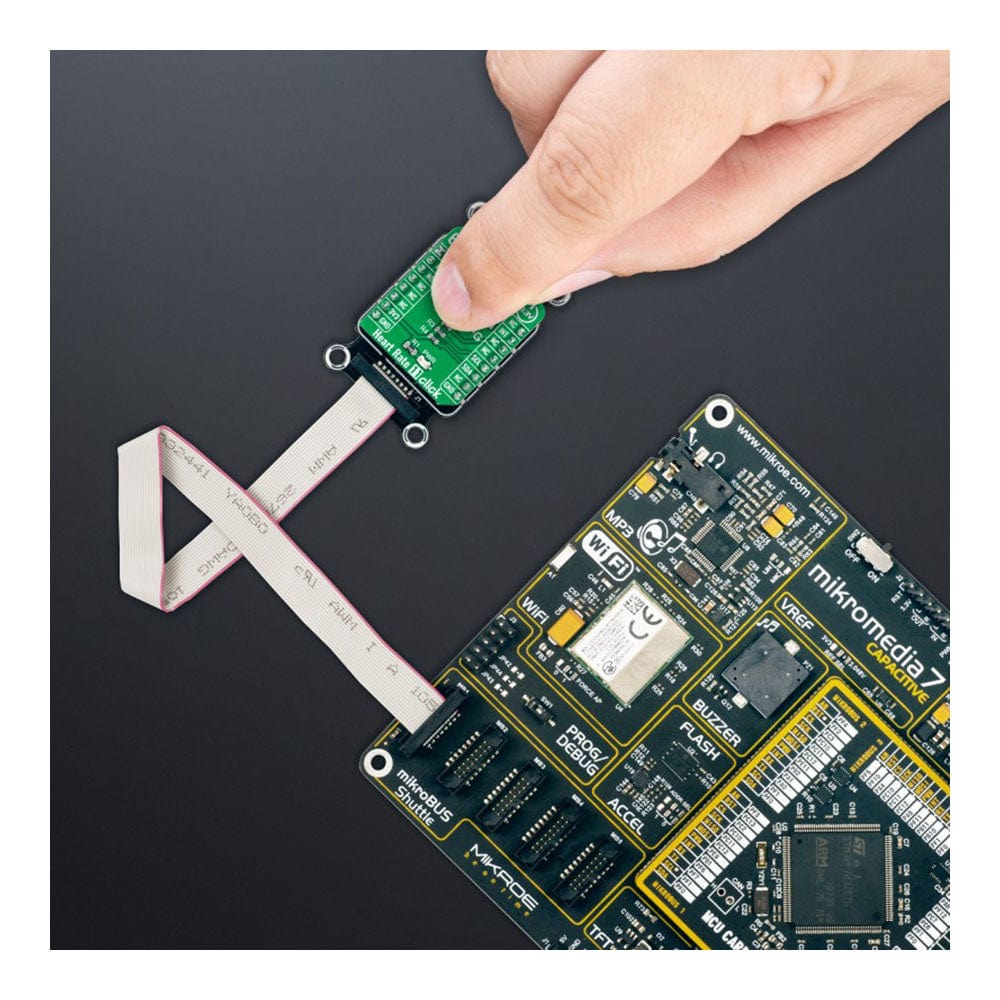
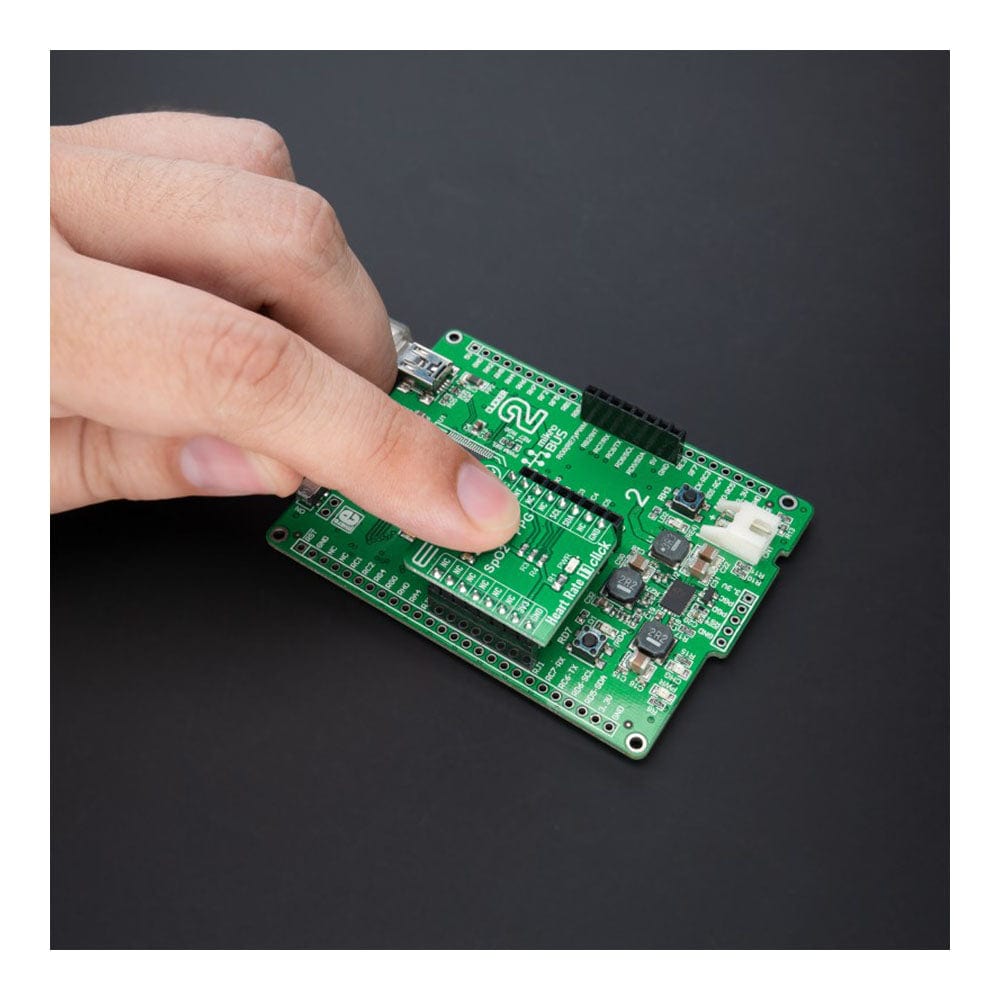
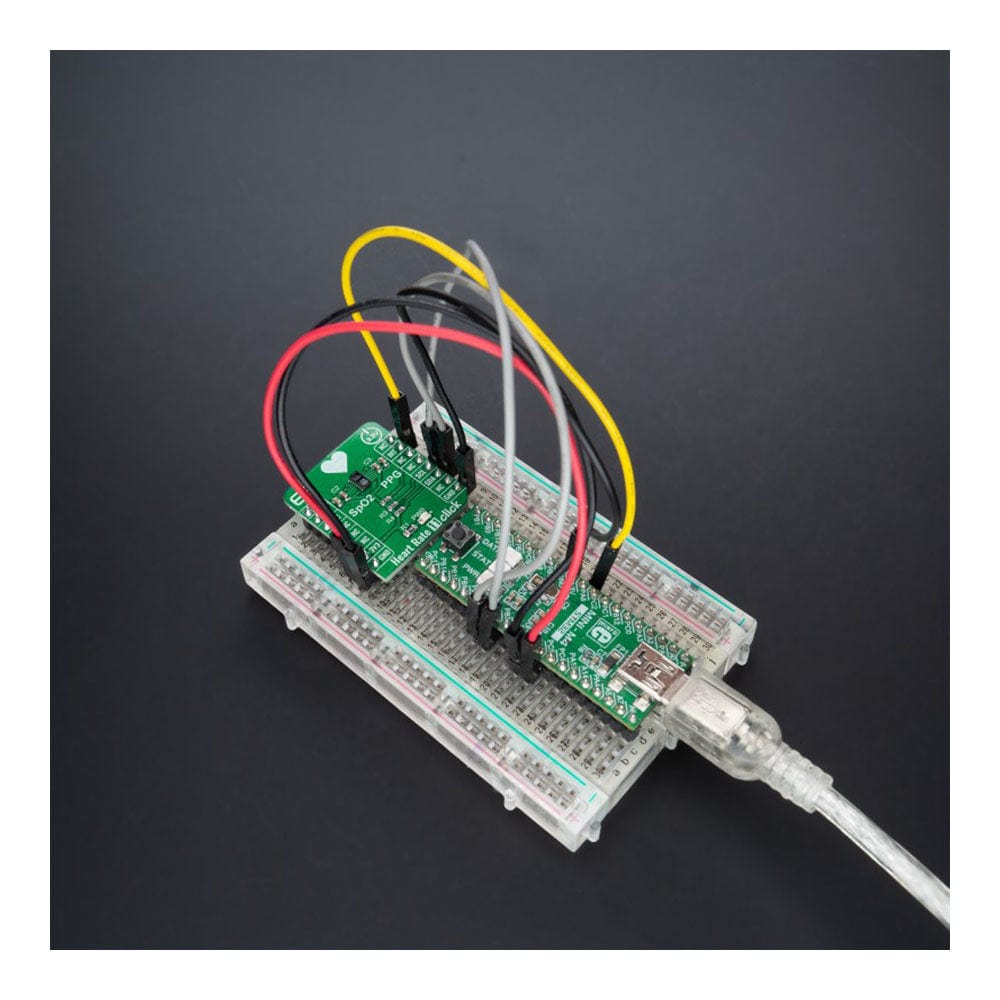
Overview
Présentation du Heart Rate 11 Click Board™
Si vous recherchez une carte complémentaire compacte, idéale pour les applications de surveillance de la fréquence cardiaque, la carte Heart Rate 11 Click Board™ est exactement ce qu'il vous faut. Dotée de l'OB1203 de Renesas, d'un capteur de lumière multicanal (LS/CS), d'un capteur de proximité (PS) et d'un capteur de photopléthysmographie (PPG), cette carte est la solution idéale pour vos besoins de surveillance.
Capacités avancées des capteurs
L'OB1203 du Click Board™ Heart Rate 11 peut fonctionner comme un capteur de lumière ambiante, similaire à l'expérience de l'œil humain. Il peut également être configuré comme un capteur de couleur RVB, permettant des mesures encore plus précises. L'OB1203 communique entièrement via une interface compatible I2C standard et dispose d'un biocapteur entièrement intégré pour la photopléthysmographie réflective. Avec l'algorithme approprié, ce Click Board™ peut déterminer la fréquence cardiaque humaine (FC), la saturation en oxygène (SpO2), la fréquence respiratoire et la variabilité de la fréquence cardiaque (une mesure du stress).
Facile à utiliser et à développer
Le Click Board™ Heart Rate 11 est pris en charge par une bibliothèque compatible mikroSDK, qui comprend des fonctions qui simplifient le développement logiciel. Cela signifie que vous pourrez démarrer rapidement et facilement, sans avoir à vous soucier du développement logiciel compliqué. De plus, le Click Board™ étant un produit entièrement testé, il est prêt à être utilisé sur n'importe quel système équipé de la prise mikroBUS™.
Obtenez votre Heart Rate 11 Click Board™ dès aujourd'hui
Ne vous contentez pas de moins que le meilleur en matière de surveillance de la fréquence cardiaque. Procurez-vous dès aujourd'hui votre Heart Rate 11 Click Board™ et commencez à surveiller votre fréquence cardiaque en toute confiance !
How Does The Heart Rate 11 Click Board™ Work?
The Heart Rate 11 Click Board™ as its foundation uses the OB1203, a fully integrated all-in-one biosensor module that measures heart rate and blood oxygen levels from Renesas. The OB1203 combines all light sources, drivers, and sensor elements, in a single optically optimized package and can be used with just one side of a user's finger because it uses the space-conserving reflective PPG method. The appropriate algorithm can determine human heart rate, respiration rate, and heart rate variability (a measure of stress) or blood oxygen saturation (SpO2) behind IR transmissive but visibly dark ink, allowing implementation in aesthetic industrial designs.
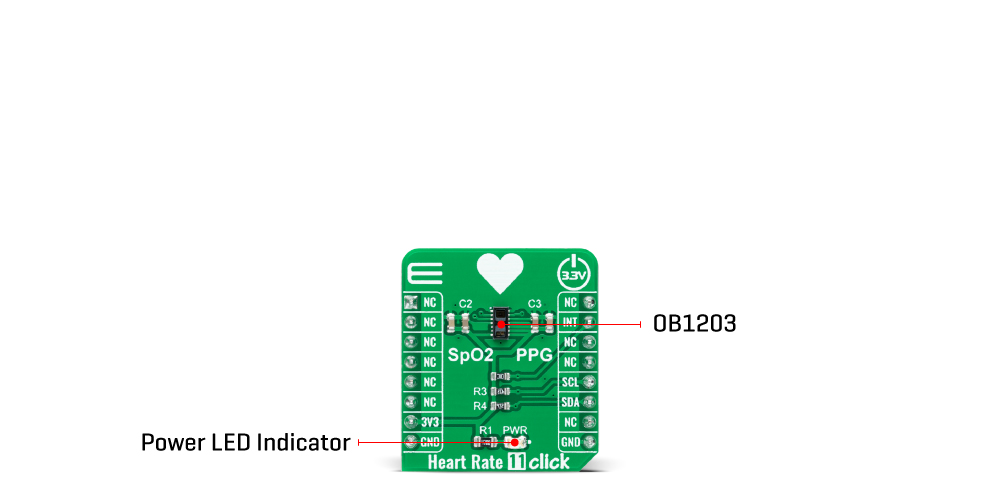
The biosensor module contains different photodiodes for light (R, G, B, and Clear channels), proximity measurements, photoplethysmography, and temperature compensation of the light sensor. Those diodes are arranged in a matrix array, while the single diode for PS/PPG measurement is located below the matrix. The current photodiode is then converted to digital values by an analog-to-digital converter (ADC) and then forwarded via a serial interface for further processing.
The OB1203 communicates with MCU using the standard I2C 2-Wire interface with a maximum clock frequency of 400kHz, fully adjustable through software registers. Also, it uses an interrupt pin, the INT pin of the mikroBUS™ socket, indicating when a specific interrupt event occurs, such as light, proximity, or photoplethysmography threshold crossed.
The Heart Rate 11 Click Board™ can be operated only with a 3.3V logic voltage level. The board must perform appropriate logic voltage level conversion before using MCUs with different logic levels. However, the Click board™ comes equipped with a library containing functions and an example code that can be used, as a reference, for further development.
SPECIFICATIONS
| Type | Biometrics,Heart Rate |
| Applications | The Heart Rate 11 Click Board™ can determine human heart rate (HR), oxygen saturation (SpO2), respiration rate, and heart rate variability (a measure of stress) |
| On-board modules | OB1203 - fully integrated all-in-one biosensor module that measures heart rate and blood oxygen levels from Renesas |
| Key Features | SpO2 measurement behind IR transmissive but visibly dark ink, high illuminance accuracy across various light sources, high sensitivity and resolution, low power consumption, object movement detection, and more |
| Interface | I2C |
| Compatibility | mikroBUS |
| Click board size | S (28.6 x 25.4 mm) |
| Input Voltage | 3.3V |
PINOUT DIAGRAM
This table shows how the pinout of the Heart Rate 11 Click Board™ corresponds to the pinout on the mikroBUS™ socket (the latter shown in the two middle columns).
| Notes | Pin |  |
Pin | Notes | |||
|---|---|---|---|---|---|---|---|
| NC | 1 | AN | PWM | 16 | NC | ||
| NC | 2 | RST | INT | 15 | INT | Interrupt | |
| NC | 3 | CS | RX | 14 | NC | ||
| NC | 4 | SCK | TX | 13 | NC | ||
| NC | 5 | MISO | SCL | 12 | SCL | I2C Clock | |
| NC | 6 | MOSI | SDA | 11 | SDA | I2C Data | |
| Power Supply | 3.3V | 7 | 3.3V | 5V | 10 | NC | |
| Ground | GND | 8 | GND | GND | 9 | GND | Ground |
ONBOARD SETTINGS AND INDICATORS
| Label | Name | Default | Description |
|---|---|---|---|
| LD1 | PWR | - | Power LED Indicator |
HEART RATE 11 CLICK ELECTRICAL SPECIFICATIONS
| Description | Min | Typ | Max | Unit |
|---|---|---|---|---|
| Supply Voltage | - | 3.3 | - | V |
| PSpectral Response (R/G/B/C) | 610/550/470/520 | nm | ||
| PPG Resolution | 16 | - | 18 | bits |
| AL Sensitivity | 0.06 | - | 150.000 | lux |
| AL&CS Resolution | 13 | - | 20 | bits |
| Operating Temperature Range | -40 | +25 | +85 | °C |
We provide a library for the Heart Rate 11 Click Board™ as well as a demo application (example), developed using MikroElektronika compilers. The demo can run on all the main MikroElektronika development boards.
The package can be downloaded/installed directly from NECTO Studio The package Manager (recommended), downloaded from our LibStock™ or found on MikroE Github account.
Library Description
This library contains API for the Heart Rate 11 Click Board™ driver.
Key functions
-
heartrate11_get_int_pinThis function returns the INT pin logic state. -
heartrate11_set_led_currentThis function sets the maximal current of the selected LED. -
heartrate11_read_fifoThis function reads a 24-bit data from the FIFO.
Example Description
This example demonstrates the use of the Heart Rate 11 Click Board™ by reading and displaying the PPG1 (HR) values which can be visualized on the SerialPlot application.
void application_task ( void )
{
// Wait for the data ready interrupt indication
while ( heartrate11_get_int_pin ( &heartrate11 ) );
uint32_t ppg;
if ( HEARTRATE11_OK == heartrate11_read_fifo ( &heartrate11, &ppg ) )
{
log_printf ( &logger, "%lurn", ppg );
}
}
The full application code, and ready to use projects can be installed directly from NECTO Studio The package Manager (recommended), downloaded from our LibStock™ or found on MikroE Github account.
Other MikroE Libraries used in the example:
- MikroSDK.Board
- MikroSDK.Log
- Click.HeartRate11
Additional Notes and Information
Depending on the development board you are using, you may need a USB UART Click Board™, USB UART 2 Click or RS232 Click to connect to your PC, for development systems with no UART to USB interface available on the board. UART terminal is available in all MikroElektronika compilers.
MIKROSDK
The Heart Rate 11 Click Board™ is supported with mikroSDK - MikroElektronika Software Development Kit. To ensure proper operation of mikroSDK compliant Click board™ demo applications, mikroSDK should be downloaded from the LibStock and installed for the compiler you are using.
Frequently Asked Questions
Have a Question?
Be the first to ask a question about this.







